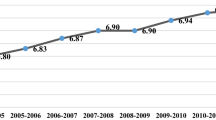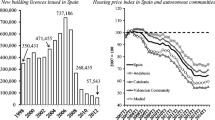Abstract
We present a microanalytical firm mobility model for the City of Hamilton, Canada, developed with data from the Statistics Canada Business Register. Contributing to the scarce literature on firm migration behavior, we explore and model the determinants of mobility among small and medium size firms who retained less than 200 employees between 1996 and 1997. Our exploratory results suggest that short distance moves are more common and tend to occur among smaller firms. Econometric modeling results support these assertions and indicate that the willingness to move can be explained by a firm’s internal characteristics (e.g. age, size, growth and industry type) as well as location factors related to the urban environment where the firm is located. The modeling results will serve as input for the development of an agent-based firmographic decision support system that can be used to inform the planning process in the study area.




Similar content being viewed by others
Explore related subjects
Discover the latest articles and news from researchers in related subjects, suggested using machine learning.References
Bade F (1983) Location behavior and the mobility of firms in West Germany. Urban Stud 20:279–297
Baldwin J, Gray T, Johnson J, Proctor J (1997) Failing concerns: business bankruptcy in Canada. Statistics Canada, Ottawa, Catalogue no. 61-525-XIE
Ben-Akiva M, Lerman S (1985) Discrete choice analysis: theory and application to travel demand. MIT, Cambridge
Bliemer M, DeBok M (2006) Infrastructure and firm dynamics: Calibration of microsimulation model for firms in the Netherlands. Transp Res Rec J Transp Res Board 1977:132–144
Bourne L (1989) Are new urban forms emerging? Empirical tests for Canadian urban areas. Can Geogr 33:312–328
Brouwer A, Mariotti I, Van Ommeren J (2004) The firm relocation decision: An empirical investigation. Ann Reg Sci 38:335–347
Dijk J van, Pellenbarg P (2000) Firm relocation decisions in the Netherlands: an ordered logit approach. Pap Reg Sci 79:191–219
Fischer MM, Nijkamp P (1985) Developments in exploratory discrete spatial data and choice analysis. Progr Human Geogr 9:515–551
Hunt J, Khan J, Abraham J (2003) Microsimulating firm spatial behavior. In: Paper presented at the eighth international conference on computers in urban planning and urban management “CUPUM”, Sendai, Japan
Kanaroglou P, South R (1999) Can urban form affect transportation and energy use and emission? An analysis of potential growth patterns for the Hamilton Census Metropolitan Area. Energy Study Rev 9:22–40
Lerman S, Liu T (1984) Microlevel econometric analysis of retail closure. In: Pitfield D (ed) Discrete choice models in regional science. Pion Limited, London, pp 181–210
Maoh H (2005) Modeling firm demography in urban areas with an application to Hamilton, Ontario: towards an agent-based microsimulation model. Unpublished PhD Thesis, School of Geography and Earth Sciences, McMaster University, Hamilton
Maoh H, Kanaroglou P (2007) Geographic clustering of firms and urban form: a multivariate analysis. J Geogr Syst 9:29–52
McFadden D (1974) Conditional logit analysis of qualitative choice behavior. In: Zarembka P (ed) Frontiers in econometrics. Academic, New York, pp 105–142
McFadden D (1978) Modeling the choice of residential location. In: Karlqvist A, Lundqvist L, Snickars F, Weibull J (eds) Spatial interaction theory and planning models. North Holland Amsterdam, pp 75–96
Miller E, Hunt J, Abraham J, Salvini P (2004) Microsimulating urban systems. Comput Environ Urban Syst 28:9–44
Moeckel R (2005) Microsimulation of firm location decision. In: Paper presented at the ninth international conference on computers in urban planning and urban management “CUPUM”, London, England
Pellenbarg P, Wissen L van, Dijk J van (2002) Firm relocation: state of the art and research prospects. Discussion Paper No. 02D31, SOM Research School, University of Groningen
Waddell P, Borning A, Noth M, Freier N, Becke M, Ullfarsson G (2003) Microsimulation of urban development and location choices: design and implementation of UrbanSim. Netw Spatial Econ 3:43–67
Wegener M, Spiekermann K (1996) The potential of microsimulation for urban models. In: Clarke GP (ed) Microsimulation for urban and regional policy analysis. Pion, London, pp 149–163
Wissen L van (2000) A micro-simulation model of firms: applications of concepts of the demography of the firm. Pap Reg Sci 79:111–134
Acknowledgment
The authors are thankful to Statistics Canada and the Social Sciences and Humanities Research Council of Canada (SSHRC) for supporting this research.
Author information
Authors and Affiliations
Corresponding author
Rights and permissions
About this article
Cite this article
Maoh, H., Kanaroglou, P. Business establishment mobility behavior in urban areas: a microanalytical model for the City of Hamilton in Ontario, Canada. J Geograph Syst 9, 229–252 (2007). https://doi.org/10.1007/s10109-007-0043-3
Received:
Accepted:
Published:
Issue Date:
DOI: https://doi.org/10.1007/s10109-007-0043-3




